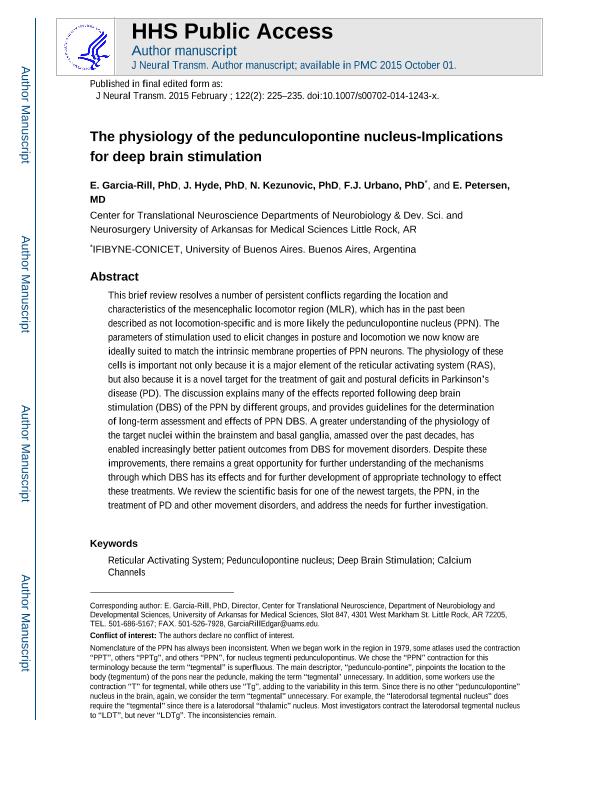Mostrar el registro sencillo del ítem
dc.contributor.author
Garcia Rill, E.
dc.contributor.author
Hyde, J.
dc.contributor.author
Kezunovic, N.
dc.contributor.author
Urbano Suarez, Francisco Jose

dc.contributor.author
Petersen, E.
dc.date.available
2017-07-11T21:46:06Z
dc.date.issued
2015-02
dc.identifier.citation
Garcia Rill, E.; Hyde, J.; Kezunovic, N.; Urbano Suarez, Francisco Jose; Petersen, E.; The physiology of the pedunculopontine nucleus: implications for deep brain stimulation; Springer Wien; Journal Of Neural Transmission. General Section.; 122; 2; 2-2015; 225-235
dc.identifier.issn
0300-9564
dc.identifier.uri
http://hdl.handle.net/11336/20204
dc.description.abstract
This brief review resolves a number of persistent conflicts regarding the location and characteristics of the mesencephalic locomotor region, which has in the past been described as not locomotion-specific and is more likely the pedunculopontine nucleus (PPN). The parameters of stimulation used to elicit changes in posture and locomotion we now know are ideally suited to match the intrinsic membrane properties of PPN neurons. The physiology of these cells is important not only because it is a major element of the reticular activating system, but also because it is a novel target for the treatment of gait and postural deficits in Parkinson’s disease (PD). The discussion explains many of the effects reported following deep brain stimulation (DBS) of the PPN by different groups and provides guidelines for the determination of long-term assessment and effects of PPN DBS. A greater understanding of the physiology of the target nuclei within the brainstem and basal ganglia, amassed over the past decades, has enabled increasingly better patient outcomes from DBS for movement disorders. Despite these improvements, there remains a great opportunity for further understanding of the mechanisms through which DBS has its effects and for further development of appropriate technology to effect these treatments. We review the scientific basis for one of the newest targets, the PPN, in the treatment of PD and other movement disorders, and address the needs for further investigation.
dc.format
application/pdf
dc.language.iso
eng
dc.publisher
Springer Wien

dc.rights
info:eu-repo/semantics/openAccess
dc.rights.uri
https://creativecommons.org/licenses/by-nc-sa/2.5/ar/
dc.subject
Pedunculopontine
dc.subject
Brainstem
dc.subject
Deep Brain Stimulation
dc.subject
Gamma Band Oscillations
dc.subject
Calcium Channels
dc.subject.classification
Neurociencias

dc.subject.classification
Medicina Básica

dc.subject.classification
CIENCIAS MÉDICAS Y DE LA SALUD

dc.title
The physiology of the pedunculopontine nucleus: implications for deep brain stimulation
dc.type
info:eu-repo/semantics/article
dc.type
info:ar-repo/semantics/artículo
dc.type
info:eu-repo/semantics/publishedVersion
dc.date.updated
2017-07-11T19:27:36Z
dc.identifier.eissn
1435-1463
dc.journal.volume
122
dc.journal.number
2
dc.journal.pagination
225-235
dc.journal.pais
Austria

dc.journal.ciudad
Viena
dc.description.fil
Fil: Garcia Rill, E.. University Of Arkansas For Medical Sciences; Estados Unidos
dc.description.fil
Fil: Hyde, J.. University Of Arkansas For Medical Sciences; Estados Unidos
dc.description.fil
Fil: Kezunovic, N.. University Of Arkansas For Medical Sciences; Estados Unidos
dc.description.fil
Fil: Urbano Suarez, Francisco Jose. Consejo Nacional de Investigaciones Científicas y Técnicas. Oficina de Coordinación Administrativa Ciudad Universitaria. Instituto de Fisiología, Biología Molecular y Neurociencias. Universidad de Buenos Aires. Facultad de Ciencias Exactas y Naturales. Instituto de Fisiología, Biología Molecular y Neurociencias; Argentina
dc.description.fil
Fil: Petersen, E.. University Of Arkansas For Medical Sciences; Estados Unidos
dc.journal.title
Journal Of Neural Transmission. General Section.

dc.relation.alternativeid
info:eu-repo/semantics/altIdentifier/doi/http://dx.doi.org/10.1007/s00702-014-1243-x
dc.relation.alternativeid
info:eu-repo/semantics/altIdentifier/url/https://link.springer.com/article/10.1007%2Fs00702-014-1243-x
dc.relation.alternativeid
info:eu-repo/semantics/altIdentifier/url/https://www.ncbi.nlm.nih.gov/pmc/articles/PMC4484763/
Archivos asociados
